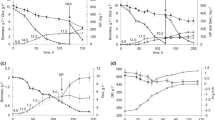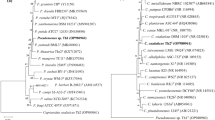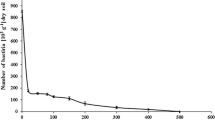Abstract
By enrichment culture technique, a fungus Penicillium waksmani Zaleski which can degrade parathion was isolated from an acid sulphate soil under flooded condition. The fungus tolerated parathion at concentrations as high as 1000 ppm. Initially, medium containing parathion supported less growth but at later stages the growth was equal to that of control treatment. Parathion was converted to aminoparathion by the fungus. The increase in the radioactivity in the aqueous phase of the culture filtrate after solvent extraction indicated the formation of certain polar metabolites.
Similar content being viewed by others
References
Ahmed, M. K., Casida, J. E.: Metabolism of some organophosphorus insecticides by microorganisms. J. econ. Entomol. 51, 59–63 (1958)
Anderson, J. P. E., Lichtenstein, E. P., Whittingham, W. F.: Effect of Mucor alternans on the persistence of DDT and dieldrin in culture and in soil. J. econ. Entomol. 63, 1595–1599 (1970)
Chacko, C. I., Lockwood, J. L.: Accumulation of DDT and dieldrin by microorganisms. Canad. J. Microbiol. 13, 1123–1126 (1967)
Ko, W. H., Lockwood, J. L.: Conversion of DDT to DDD in soil and the effect of these compounds on soil microorganisms. Canad. J. Microbiol. 14, 1069–1073 (1968)
Lichtenstein, E. P., Schulz, K. R.: The effects of moisture and microorganisms on the persistence and metabolism of some organophosphorus insecticides in soils, with special emphasis on parathion. J. econ. Entomol. 57, 618–627 (1964)
Martin, J. P.: Use of acid, Rose-Bengal and Streptomycin in the plate method for estimating soil fungi. Soil. Sci. 60, 215–231 (1950)
Matsumura, F., Boush, G. M.: Degradation of insecticides by a soil fungus, Trichoderma viride. J. econ. Entomol. 61, 610–612 (1968)
Raper, K. B., Charles, T., Dorothy, I. F.: A manual of the Penicillia. Baltimore: The Williams & Wilkins Co. 1949
Sethunathan, N.: Degradation of parathion in flooded acid soils. J. Agr. Food Chem. 17, 602–604 (1973a)
Sethunathan, N.: Microbial degradation of insecticides in flooded soil and in anaerobic cultures. Residue Rev. 47, 143–165 (1973b)
Zuckerman, B. M., Deubert, K., Mackiewicz, M., Gunner, H.: Studies on the biodegradation of parathion. Plant and Soil 33, 273–281 (1970)
Author information
Authors and Affiliations
Rights and permissions
About this article
Cite this article
Rao, A.V., Sethunathan, N. Degradation of parathion by Penicillium waksmani zaleski isolated from flooded acid sulphate soil. Arch. Microbiol. 97, 203–208 (1974). https://doi.org/10.1007/BF00403059
Received:
Issue Date:
DOI: https://doi.org/10.1007/BF00403059




